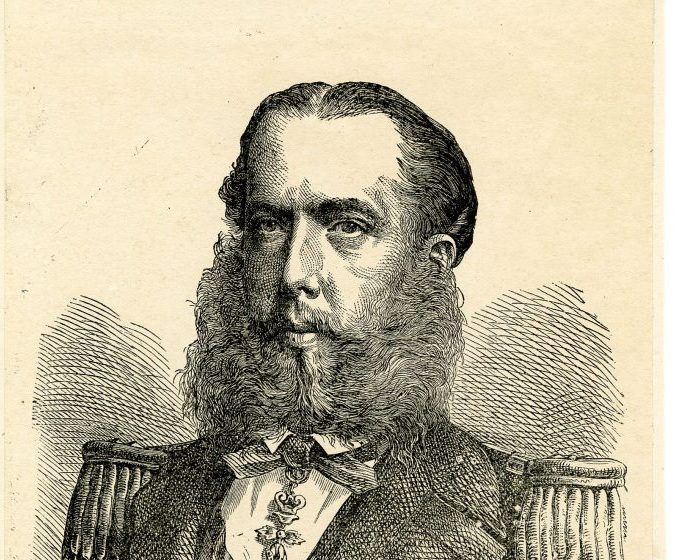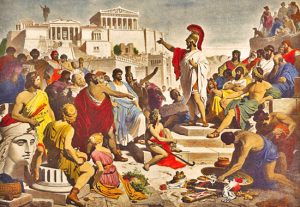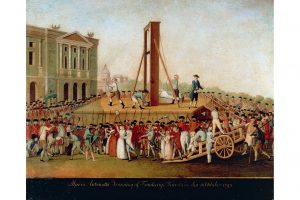
In 1864, an energetic and ambitious young man sailed from Austria to Veracruz, Mexico in hopes of ruling a foreign land. He arrived with his wife, an army, and many false assumptions and misleading facts about what he was getting himself into. Maximilian I was an educated, motivated man who renounced any rights to the Austrian throne and to his Austrian Archduke title in order to become the emperor of Mexico. Although Maximilian was in power for only three short years, from 1864 to 1867, he fell in love with Mexico and with its people. His patriotism for Mexico was admirable, yet that love is not mentioned enough in history. Maximilian’s own ambition to lead and protect the Mexican people resulted in the downfall of his career as the second and last emperor of Mexico.

Ferdinand Maximilian Joseph was an Austrian archduke, born to Archduke Francis Charles of Austria and Archduchess Frederica Sophia in 1832. From an early age, Maximilian became interested in the arts and sciences, and had a passion to explore the sea. This resulted in him making various trips around the globe, particularly to Mediterranean lands like Greece, Crete, Palestine, and Egypt. By 1853, he had become commander-in-chief of the Austrian Navy. 1856 and 1857 were also important years in Maximilian’s early career. In one of his trips around Europe, he met and fell in love with Princess Carlota of Belgium, Maximilian’s future wife. Maximilian and Carlota’s marriage was not arranged. The young archduke expressed his interest to Carlota’s father and he agreed to the marriage. During Maximilian’s European trip, he also met with Napoleon III of France during his visit to Paris in 1856. Soon after Maximilian and Carlota’s marriage in 1857, Maximilian’s older brother, Emperor Franz Joseph I of Austria, made him the governor-general of the Lombardo-Venetian Kingdom, where Maximilian gained experience being an efficient ruler. Maximilian’s rule ended in 1859, due to the war that broke out between Italy and Austria in that year. Maximilian then retired to the Miramar castle in Trieste and spent his leisure time reading and admiring art.1
In October of 1863, Mexican officials arrived at Miramar to offer a crown to Maximilian. Mexico’s economic, social, and political status was in shambles after their fight for independence from Spain in the decades after 1821. After that war, the Mexican Republic’s politics was divided between liberals and conservatives: liberals wanted to curb the power of military elites and Catholic priests, and institute various liberal reforms, like freedom of speech, while conservatives wanted to restore older ideals. As a result, Mexican conservatives reached out to Archduke Maximilian for help in restoring conservative values. They wanted to abolish President Benito Juarez’s new liberal reforms, and regain control Mexico.2
After declining the offer the first time the throne was offered, Maximilian asked the Mexican conservatives to hold a referendum in Mexico, to make sure that the Mexican people really wanted him as their emperor. The results came back overly positive, and therefore Maximilian decided to take the throne. He acceded to the Mexican throne with his wife Carlota in 1864. The couple was eager to rule a foreign land, yet they failed to see that they were going to Mexico under false pretenses.3 Mexican conservative officials falsified the results of the referendum that Maximilian needed to accept the throne.4 Because he was led to believe that the Mexican people needed and wanted him, he happily accepted. Supporting Maximilian was the French government and the Mexican conservatives. France used Maximilian’s position as emperor as an opportunity to collect debts that President Benito Juarez had canceled. Napoleon III therefore financed Maximilian’s voyage and also provided troops to protect the royal couple.
Maximilian and Carlota arrived in Mexico City on June 12,1864. Two days later, he began to get involved in politics and in the Republic’s affairs. Appointing consuls and ministers, handling debt, forming courts of justice, and establishing the national flag were issues that he energetically approached. Maximilian took his position of monarch very seriously. He wanted to be a leader, and not a tyrant. In the first ceremony since ascending to the throne, Maximilian was dressed in the uniform of a Mexican general with Mexican insignias. This demonstrated how approachable Maximilian wanted to appear. One of Maximilian’s first decrees was that he would hold a public forum every Sunday afternoon in order for people to address him personally in order to hear their complaints. Maximilian’s top priorities were to promote welfare among all subjects and reward his subjects’ loyalty. He promoted welfare by abolishing serfdom and child labor, and by raising wages.5 Both the Emperor and the Empress encouraged education and support for all, especially the poor. They built, visited, and maintained hospitals, which provided healthcare for all. His Majesty was not selfish or materialistic. He cut his annual, monarchical earnings by one third and gave two thirds of his money to charity and poor communities.6 Although he gave priority to liberal reforms, to strengthen his political relationship with Benito Juarez, Maximilian made the error of not being harsh enough on Juarez. Juarez then traveled to northern Mexico to gather his army and gain arms to overthrow the empire.
Maximilian spent most of his time trying to create an alliance with Juarez, an alliance that could have saved the monarchy. The Emperor wished to strengthen his relationship with Juarez by instituting liberal reforms and maintaining the ones that Juarez had previously established. Many of these reforms involved affairs with the Catholic Church. Maximilian refused to restore the Catholic Church’s lands after they were confiscated by Juarez. He championed freedom of religion and the separation of church and state. All of these actions only infuriated the Catholic Church and isolated Maximilian, a Catholic monarch, from his Catholic and conservative supporters.7 Maximilian’s decisions to go against the Catholic Church gravely endangered his relationship with the Vatican, and ultimately led to his death.
After the United States’ Civil War ended in 1865, the United States was in a better position to supply arms to Juarez’s revolutionary army. It was convenient for the US to support Mexico, because it did not want European influences in its hemisphere. The supply in arms made Juarez’s army stronger and more able to defeat the empire. As a result, Maximilian made the grave error of announcing the “Black Decree,” which mandated the execution of any Mexican that bore arms and planned to use them against the empire. The Black Decree depicted Maximilian as a tyrant and turned more people against him. As more armed conflicts broke out, Carlota, the Empress, traveled to Europe in 1866 to seek help from Napoleon III of France, Pope Pius IX in the Papal States, and even Maximilian’s older brother, Francis Josef I of Austria-Hungary. Because Maximilian had failed to conquer Mexico for Napoleon III and resume paying back the debt that Mexico owed to France, Napoleon III did not agree to help Maximilian. The Vatican also refused to help the monarch because of Maximilian’s reforms against the Catholic Church.8 Even with Carlota at Saint Cloud, Napoleon III’s residence, Napoleon III refused to see her. In 1867, as Napoleon III gave up the hope of acquiring Mexican soil and having his debts repaid, he commanded French troops to retreat in three stages, and Maximilian was left with a small army and a few loyal subjects.9

In May of 1867, Maximilian was forced to leave Chapultepec Castle, his residence, in Mexico City, to go to Querétaro to enhance his safety. Querétaro would provide a safe haven for him, although Juarez’s army was approaching. Maximilian still believed that some European army would come rescue him just in time, but in reality, he had no actual support. Maximilian, his followers, and the Empress’s Regiment took shelter in a fortress, where trusted military officials guarded entrances at all times. At midnight, what seemed like a safe haven, turned into a war zone for Maximilian and his small army. One of the captains guarding the main entrance was surprised by an ambush of Juarez’s army. The captain received a shot from behind and fell to the ground. While he composed himself, he caught a glimpse of a familiar face through the dim of the candles along the hallway. In the distance, he could see that the ambush was led by Colonel Miguel Lopez, one of Maximilian’s most trusted commanders. Maximilian’s own army had turned against him and the empire. Muskets and weapons were fired off, and by dawn, the imperial army was surrounded by Republican forces.10 Maximilian wasn’t informed of the treachery until morning, to which he responded only with silence. Colonel Lopez himself arrested Maximilian and gave orders that he should be imprisoned and isolated. His fate was decided for him by Mexican officials, and after two days, he was found to be an “enemy of the state” and a threat to the wellbeing of the people. Because Maximilian had issued the Black Decree in 1865, President Benito Juarez and the Mexican people now considered Maximilian a menace. Juarez then found no alternative than to sentence him and two of his most loyal companions, General Miguel Miramón, and General Tomás Mejía, to death.11 Many European politicians and monarchs, including Francis Josef I of Austria, pleaded with Benito Juarez to spare Maximilian’s life. Juarez’s plans were different. He wanted to make an example out of Maximilian so that Europeans would stop intervening in Mexico’s affairs and accept Mexico as a new, independent republic. As a result, Maximilian I, Miguel Miramón, and Tomás Mejía were executed on June 19, 1867 by Juarez’s army. Before Maximilian’s death, he wrote a letter to his wife, Carlota, where he expressed how much he wished she was with him and how happy she had made him. Up until his death, Maximilian remained a Mexican at heart. He never insulted the Mexican army or their beliefs. Before dying, Emperor Maximilian said, “I will die for a just cause, for the independence and liberty of Mexico. May my blood seal the disgraces of my new homeland.”12 He concluded his overall statements with the words “Viva Mexico,” before being shot next to the two generals.13

After Maximilian’s death, Juarez wasn’t able to restore control and tranquility to Mexico. He had one term as president and not long after, he died in 1872. Empress Carlota never returned to Mexico after 1866. After help was denied from European powers, she had a nervous breakdown that damaged her mental health immensely. As she grew old, she would hallucinate that she was still the empress of Mexico and that her husband was alive. She even kept a doll next to her bed, whom she called “Max.” Almost fifty years after her husband’s death, she passed away in 1927.14
Maximilian’s career in Mexico was destined to fail even before it began. His monarchy was supported by people whose only intentions were to receive something in return. Even more, Maximilian was unable to gain allies and create diplomatic relationships with other important figures. His naivety to trust Mexican conservatives and unwillingness to accept that Mexicans wanted their sovereignty and independence, led to his downfall. The story of Maximilian I of Mexico is to be remembered due to his passion for Mexico and its people. Maximilian genuinely believed that he was chosen both by the people of Mexico and by God to rule. In return, he did so with the utmost respect, care, and tolerance.
- J. Kemper, Maximilian in Mexico (Project Gutenberg), accessed (April 6, 2021), 12-16. ↵
- J. Kemper, Maximilian in Mexico (Project Gutenberg), accessed (April 6, 2021), 16. ↵
- Susanne Igler and Spiller Roland, Más nuevas del imperio, Más nuevas del imperio (Vervuert Verlagsgesellschaft, 2001), 27. ↵
- George P. Messerby, The Quick-Step of an Emperor: Maximilian of Mexico (London, 1921), 81-90. ↵
- United States Department of State, Foreign Relations of the United States (U.S. Government Printing Office, 1866), 668. ↵
- Frederic Hall, Life of Maximilian I. : Late Emperor of Mexico, with a Sketch of the Empress Carlota, Making of America., Making of America (J. Miller, 1868), 139-141. ↵
- Ute Seydel, “Memorias de Concepción Lombardo de Miramón. Una reflexión sobre el proyecto político fallido de Maximiliano de Habsburgo, Napoleón III y el partido conservador mexicano,” Anuario de Letras Modernas 14 (2008), 106. ↵
- Susanne Igler and Spiller Roland, Más nuevas del imperio, Más nuevas del imperio (Vervuert Verlagsgesellschaft, 2001), 37. ↵
- Tina Schwenk, “Maximilian I – A Habsburg on Montezuma’s Throne,” October 2010, 224. ↵
- George P. Messerby, The Quick-Step of an Emperor: Maximilian of Mexico (London, 1921), 272-273. ↵
- Benjamin Wood, “Mexican Standoff: French Emperor Napoleon III Landed Troops in Mexico in 1861 and Pushed a Puppet Monarch on the Divided Nation–until Republican Forces Supported by the United States Pushed Back,” Military History (World History Group, LLC, November 1, 2015), 7. ↵
- Maximilian et al., Causa de Fernando Maximiliano de Hapsburgo, Que Se Ha Titulado Emperador de México, y Sus Llamados Generales Miguel Miramón y Tomás Mejía Sus Cómplices Por Delitos Contra La Independencia y Seguridad de La Nación, El Orden y La Paz Pública, El Derecho de Gentes y Las Garantías Individuales (Mexico: A. Pola, 1907), 590. ↵
- Susanne Igler, Spiller Roland, Más nuevas del imperio, Más nuevas del imperio (Vervuert Verlagsgesellschaft, 2001), 133. ↵
- Tina Schwenk, “Maximilian I – A Habsburg on Montezuma’s Throne,” October 2010, 224. ↵




22 comments
Valeria Varela
Was a fascinating and well written article about Maximillian and his history with Mexico. I actually spoke to my dad about this article in which he replies that Maximillian was destined to fail from the very beginning. Calling him quite ignorant emperor and not really knowing how he even got so far. In the perspective of my dad’s Mexican education, this emperor wasn’t painted in such a great light. It’s unfortunate to see someone that truly had the intention to help the Mexican people only for it to be the death of him.
Allison Grijalva
Hi Paula! I was not familiar with this story before, but it was very interesting to read and learn about. Your article was extremely easy to follow in order of events and I liked the connection between Maximillian’s power in Austria to his power in Mexico. It is also interesting as you note that he arrived in Mexico with an army, insinuating that he was ready to conquer this land and the people. It is unfortunate that in Latin America this is not an uncommon theme throughout history. Great job!
Faith Chapman
This is a great article. I am not sure if I have ever heard of Maximillian I, but he seemed like a great historical figure, a man before his time. I think current political leaders could learn something from him, and it’s a shame that the Mexican people didn’t see the things he was doing was for their interest, but I suppose his end was inevitable since it seems like he was incapable of noticing that the Mexican people wanted sovereignty and independence; I honestly think he would have renounced his Austrian citizenship as well to become a Mexican citizen and fought for Mexico’s sovereignty if he was more aware. Again, this a great article.
Edgardo Llosa
Really interesting Article about Maximilian it was engaging and had a lot of information about his history from Austria to Mexico and his years as a ruler. I followed a good order which made me read smoothly with no problems or confusion. I liked how he continues his story until the end of his life and makes it really interesting.
Danielle Slaughter
Hey, Paula.
This was an exceptionally well-written article. I had been unfamiliar with the rule of Maximilian I. Of course, I had heard the name, perhaps seen it perusing a history book, but that’s about it. It strikes me that he was an emperor who truly had the best interests of the nation of Mexico as a whole, but his being a European outsider — and his issuing of the Black Decree, his undoing — placed him under intense scrutiny. It is a shame what became of him. It’s hard to say if this was a case of power corruption, or simply a man who used this power to the best of his ability and failed to rein it in.
Madeline Chandler
In all honesty, I did not know this aspect of Mexican history. You did a great job of explaining the chronological movement and rise of power of Maximillian. It is such an interesting story, I wish I had known growing up. What is even more remarkable is that he was an Austrian duke that transitioned to Mexican President. Thank you for sharing this piece of fascinating history.
Santos Mencio
A good article that presents an honest take on a man who is often depicted as a tyrant in historical accounts. His biggest mistake was inadvertently confirming the worst fears of the revolutionaries by enacting the Black Decree in 1865. The fate of Empress Carlota is truly a saddening one, one that I hope no one else ever has to endure.
Trenton Boudreaux
A very well written article on a period of history I rarely hear about. It is interesting how despite coming to power under false pretenses, Maximillian was seemingly a decent ruler for Mexico, and he truly loved the culture, country, and people. Unfortunately, as the article writes, the black decree ruined him and any ruler that comes to power under false pretenses without enough information is doomed to fail.
Aaron Sandoval
I had never heard of Maximillian, but this article was easy to follow and understand. I really liked the flow of this article and how the author was able to cover not only the journey from Austra to his position in Mexico but also the political climate in Mexico that allowed for him to get to that position. It is no surprise that his monarchy failed given the U.S. support of Juarez as well as the little political and social support Maximillian had.
Rhys Kennedy
A very well done and informative article. All of this information and this story I have never heard of before reading this article so it was really interesting to read. Even though the name and story of Maximilian might have popped up in some history class of mine, that lesson was not nearly as interesting as it was to read about his story in this article.